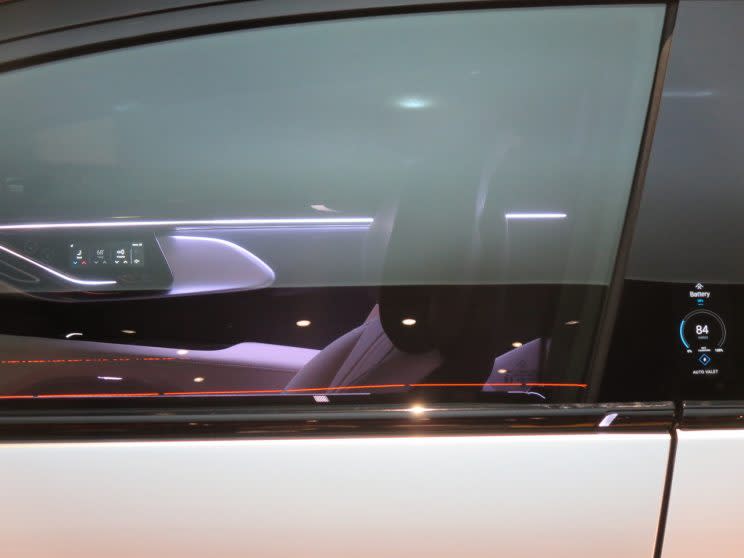Faraday Future’s FF 91: Electric speed at a vaporous price

The FF 91 supercar that the electric-car startup Faraday Future showed off at an event here Tuesday has one definite advantage over the concept vehicle the company unveiled at last year’s CES: It moves.
Executives at the Los Angeles firm demonstrated that by having a test car daintily park itself in a lot outside a hangar-sized event venue near downtown Las Vegas. Later, a human driver pulled up in front of the stage in an FF 91 and floored it, exiting stage left in a whir — slightly quicker than the Bentley Bentayga, Ferrari 488 and Tesla’s Model X and Model S that other drivers had just put to the same test, and a lot quieter than those first two gas-powered vehicles.
But in a second demonstration of the FF 91’s self-parking capabilities, the vehicle balked on the first try. And attendees only got to see the FF 91’s fully autonomous, highway-speed capability — powered by an array of cameras, radars, ultrasonic sensors and a LIDAR laser sensor that pops out of the hood in self-driving mode — in a few slickly produced videos.
Other parts of the presentation highlighted a dizzying array of connected-car features. The FF 91 will use face-detection technology to recognize you as you walk up to it, then preload customized settings from your “FF ID” that cover everything from your preferred seat settings to your music playlists and favorite places. (This made the car sound a bit like a Facebook with the technical capability of running you over.)
The FF 91, which looks a bit like a futuristic Lexus RS300 SUV, will also include multiple LTE modems to ensure constant bandwidth and allow the car to function as a very expensive hotspot.

But exactly how expensive? You’ll have to wait to find out. The company went an hour and 12 minutes without naming a price, although it did invite interested shoppers to put down a refundable $5,000 deposit at its web site to be among the first to buy the production version when it ships in 2018, a year later than once forecast. Or you can pay an unspecified premium in March to trade up to one of 300 “Alliance Edition” early-build models.
When asked for some kind of hint about pricing after the presentation, Jason Wallace, Faraday’s director of experiential marketing, told me that the FF 91 would start in the “low hundred thousand dollar range.”
That’s neither cheap nor out of whack for the high-end car market. And if the FF 91 lives up to Faraday’s promises for acceleration and range, it might warrant paying that sort of price. Beyond a 0-60 mph time of 2.33 seconds — technically impressive but meaningless or dangerous on many public roads — the company touts a range between charges of more than 378 miles.
Faraday executives credited a massive 130 kilowatt-hour battery (in comparison, the Model S comes with a choice of 70 or 90 kWh batteries) as well as advanced software that enables more efficient operation.

“It’s never been more convenient to drive completely electric,” propulsion-engineering vice president Peter Savagian said onstage.
First, though, the company needs to work its way out of some setbacks that Tuesday’s event only alluded to in the vaguest terms. The most serious among them: November’s stoppage of work on a $1 billion factory north of Las Vegas after the company reportedly fell behind on payments. Faraday’s presentation proudly labeled that as the end of “phase one” of construction.
(Wallace said this halt was not just a matter of funding but also of needing construction permits.)
Distribution also remains at a vaporous state. The company plans to do all its sales online. “We really want the internet to be our interface,” Wallace said. But that seems likely to encounter some of the same legal hang ups that Tesla has had in setting up manufacturer-to-driver sales.
Too many of the talking points Tuesday that were supposed to dispel concerns along those lines amounted to startup word-salad bravado. That did not help its cause.
“We don’t even consider ourselves a car company; we’re a tech company, reformatting the future of mobility,” senior engineering vice president Nick Sampson told the crowd early on. “Disruption is what drives us in every facet of our business.” If I had a dollar for every time I’ve heard dot-com founders testify along those lines, I could easily cover the deposit on an FF 91.
More of Yahoo Finance’s CES coverage:
Lenovo’s Smart Assistant uses Amazon’s Alexa to control your home
What to expect this week at CES, the world’s biggest gadget show
Fiat Chrysler’s Portal concept is an upgradable car for millennials
The Norton Core is a beautiful Wi-FI router that protects your digital home
Samsung’s new washing machine will save you time and aggravation
The biggest busts from the world’s most renowned gadget show
Email Rob at [email protected]; follow him on Twitter at @robpegoraro.
